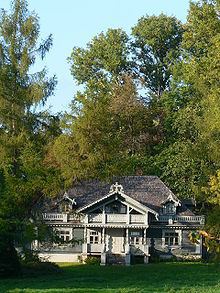Time zone CET (UTC+1) Elevation 163 m Local time Wednesday 6:48 AM | Established 1699 Postal code 17-230 Population 2,670 (2002) | |
 | ||
Weather 6°C, Wind S at 14 km/h, 86% Humidity Points of interest Muzeum Przyrodniczo‑Leśne Białowies, The Grodno Governor, Stacja kolejowa Białowież, Park Pałacowy w Białowi, Dębowa Dziupla | ||
Białowieża [bʲawɔˈvʲɛʐa] (Belarusian: Белавежа Biełavieža, Lithuanian: Bialovieža, Russian: Беловежская Belovezhskaya) is a village in Poland, in Podlaskie Voivodeship, in the middle of Białowieża Forest, of which it is a namesake. The population of the settlement is 2,000 (2002). It lies approximately 21 kilometres (13 mi) east of Hajnówka and 66 km (41 mi) south-east of the regional capital Białystok.
Contents
Map of Bia%C5%82owie%C5%BCa, Poland
Geographic location
Białowieża is in north-eastern Poland in the Podlaskie Voivodeship near the border with Belarus. The nearest city is Białystok, which is the capital of the voivodeship. Białowieża is also connected to the town of Hajnówka some 20 km (12.43 mi) away. The Narewka river flows through Białowieża.
Białowieża is the seat of the administrative district of Gmina Białowieża, which encompasses an area of 203 km2 (78.38 sq mi) and has a population of 3068 (2000). Other villages in Białowieża area are Budy, Gródek, Pogorzelce, and Teremiski.
Before 1426 a wooden hunting manor for king Władysław Jagiełło was built in the middle of the Białowieża Forest on the Lutownia stream. It was most probably one of the first permanent settlements in the area, although the forest was already penetrated by hunters from the nearby areas and by the king himself who won't to hunt there. The wooden manor was painted in white and became the namesake both for the future village and the forest (Białowieża means White Tower in Polish).
From 1538 the forest was protected by the laws of king Sigismund I the Old. However, until the times of John Casimir the forest was mostly unpopulated. Sporadic settlements were established in various places, but the manor in Białowieża was the only one to be permanent. In the late 17th century, several small villages were started for development of local iron ore deposits and tar production. The villages were populated with settlers from Masovia and Podlaskie and many of them still exist.
After the Partitions of Poland the local population was turned into serfs and Białowieża quickly depopulated. Tsar Alexander I reintroduced the reserve in 1801 and hired a small amount of peasants for protection of the animals. Most of them were settled in the administrative centre of the area - Białowieża. However, since most of the foresters took part in the November Uprising (500 out of 502 in total), their posts were abolished and protection was again harmed. Yet again the village of Białowieża ceased to exist. Protection was reintroduced in 1860 and the village was repopulated with Russians.
During World War I most of the local Russian population fled before the advancing German army which seized the area in August 1915. The Germans built a lumber mill in Białowieża, connected to the nearby town of Hajnówka by a railway. However, the village did not recover until 1921 when the Białowieża National Park was established. The village became the administrative center of the Park and one of the most popular tourist attractions of the area. Following the Polish-Soviet War, Białowieża was returned to Poland.
During World War II, after the joint German and Soviet attack on Poland, the area came under Soviet occupation. In 1939 and 1940 most of the local inhabitants were arrested and sent to gulags. They were replaced with Russian forest workers, but in 1941 the forest came under German occupation and the Russian inhabitants were also deported. Hermann Göring planned to create the biggest hunting reserve in the world there, but those plans were never realized. After July 1941, the forest became a refuge for both Polish and Soviet partisans. The German authorities organized mass executions of people suspected of aiding the resistance. In July 1944 the area was captured by the Red Army. The withdrawing Wehrmacht blew up the historic Białowieża hunting manor.
After the war Białowieża yet again recovered and became the center of the re-established National Park in 1947. Nowadays it is one of the least populated areas in Poland, while at the same time it is one of the most important tourist attractions in the eastern part of the country with almost 100,000 visitors every year. The Reserve was inscribed on the World Heritage List in 1992 and internationally recognized as a Biosphere Reserve under UNESCO's Man and the Biosphere Program in 1993.
British historian Simon Schama devotes several chapters of his 1995 book Landscape and Memory to a consideration of the historical vicissitudes of the forests around Białowieża in an effort to explore the ways in which cultural imagination shapes humans' vision of the land.
